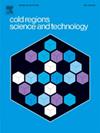Experimental study on the technology optimization of clear ice thickness detection on horizontal cold plate surface by using microwave resonance
Abstract
The accumulation of snow and ice has the potential to have a negative impact on numerous industries if it is not accurately detected and processed in real-time. Microwave resonators have gained interest as durable and reliable ice detectors. To detect the thickness of clear ice slices on a horizontal cold plate surface, a capacitively coupled split-ring resonant sensor was experimentally investigated. To ascertain the efficacy of the sensor, plexiglass with similar relative permittivity to ice was firstly tested. The effect of the plexiglass plate thickness on the resonance amplitude of the transmission scatter parameter was found to be monotonic in the range of 16.8 mm thickness, thereby demonstrating the ability of the sensor to accurately measure plate thickness. Then, the effect of different thicknesses of clear ice slices within 17.0 mm on the resonance parameters was tested under constant temperature. The resonant amplitude decreased by 46.55% from −4.13 dB to −6.05 dB, as the thickness of the clear ice slice gradually increased from 2.5 mm to 17.0 mm. A model for the detection of ice thickness based on the analysis of theoretical principles and experimental data was developed. The ice thickness could be detected accurately within a range of 17.0 mm at temperatures between −3 and −20 °C, with a maximum deviation of 5.66% in the detection of ice thickness. This study validates the application of the sensor to detect ice thickness, such as on ships, roads and aircraft.

 求助内容:
求助内容: 应助结果提醒方式:
应助结果提醒方式:


